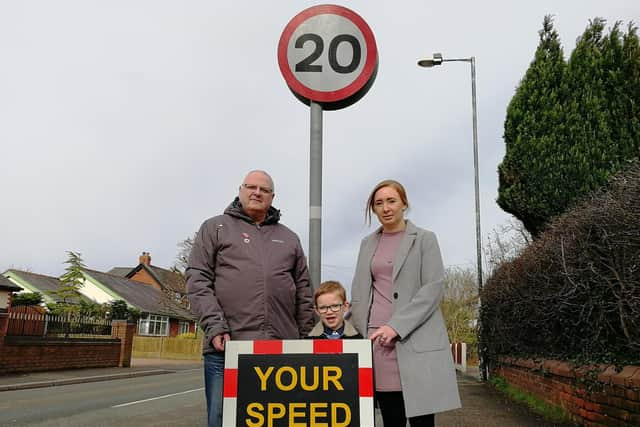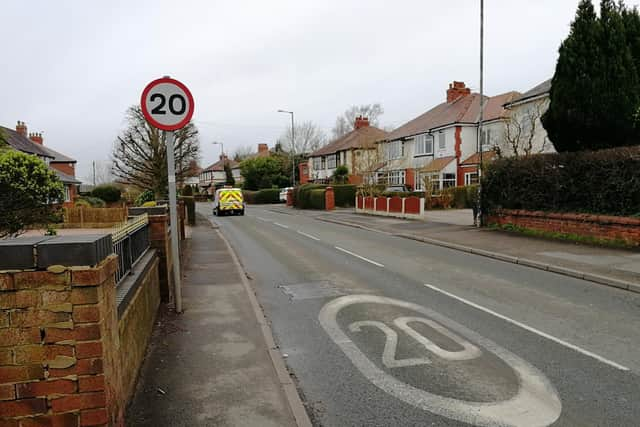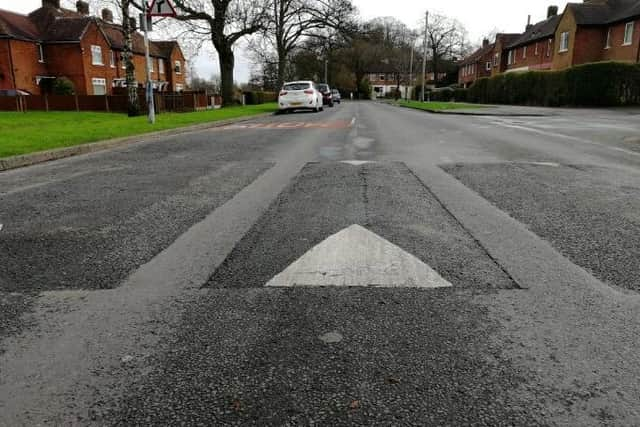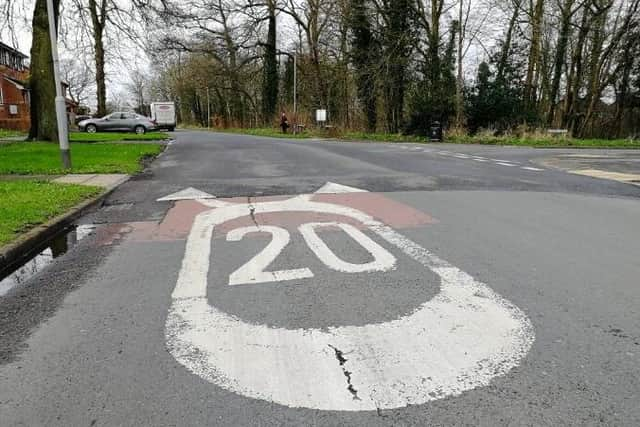Child safety fears over speeding on Preston's residential streets
and live on Freeview channel 276
Sue Kirkham’s pet was thrown into the air after being struck on Lea Road in Savick just before Christmas by a driver who failed to stop.
The mum-of-two later witnessed the shocking incident after discovering that it had been captured on CCTV just yards from her own front door.
Advertisement
Hide AdAdvertisement
Hide AdWhile acknowledging that “accidents happen”, Sue fears that the next one could involve the most vulnerable of road users.


“There have been numerous collisions involving people's pets and a few weeks ago, an adult was clipped by a car on the narrow pavement close to the junction with Blackpool Road.
“He wasn’t hurt, but it could have been a different story if it had been a child who had been hit - and I worry it’s only a matter of time before that happens.
“It’s chaos the way drivers speed along here - there’s just no respect for the residents living on this street,” said Sue of her 20mph road.
Advertisement
Hide AdAdvertisement
Hide AdShe added that she will think twice before allowing her own children - five-year-old Jack and his three-year-old sister Sophia - to walk unaccompanied to their nearby school even when they are old enough to do so.


The loss of the family’s beloved ‘Mr. Cat’ prompted Sue to design her own warning signs incorporating an image of the seven-year-old moggy - to make drivers think twice about their speed.
However, she was refused permission by Lancashire County Council to put them up - with the authority instead installing its own “Let’s Look Out For Each Other” signage which is temporarily erected in response to concerns raised about speeding in an area.
“I had an idea in my head - I was going to use a picture of the cat and be a bit emotive about it. I’d even found a company to make them, but the county council said that I couldn’t attach them to the lampposts.
Advertisement
Hide AdAdvertisement
Hide Ad“But the signs the council have put up are not going to have any impact whatsoever - I’ve counted only two along the whole road. My husband drives down here every day and he hasn’t spotted them at all.


“Other areas have these huge yellow-bordered 20mph signs telling people to ‘please drive carefully’," added Sue - who also questioned why the permanent speed signs which are in place are situated about 100 yards in from the start of the road.
According to local anti-speeding campaigner Roger Baines, the safety risk to road users in Savick could be reduced by speed humps - but only if lessons are learned from the way they have been installed on the Larches side of Blackpool Road.
Larches Lane saw the traffic-slowing measures put in place around four years ago to help enforce the road’s 20mph limit. But Roger - who chairs the Larches and Savick Police and Communities Together (PACT) group - claims that the design of the bumps means drivers do not even have to hit the breaks.
Advertisement
Hide AdAdvertisement
Hide AdOn wider stretches of the road, the speed cushions come in threes - with the middle one narrower than the two situated either side of it.


“If you drive at any of them properly, they don’t really have any effect - and if you go down the middle of the road, you can go through without hitting them at all.
“If there was nothing coming, I could drive down the middle at 70mph if I wanted,” Roger warned.
He said that data he has seen suggests some drivers are not far from achieving motorway speeds - with several clocked at 60mph when a mobile speed indicator device (SPID) has been used on the residential street.
Advertisement
Hide AdAdvertisement
Hide AdThe suggestion that some motorists could be driving at three times the speed limit comes as no surprise to Larches Lane resident Barbara Pickup, who is often drawn to her living room window in fear of what she was may witness.
“You can often hear them before you see them”, said the 75-year-old, who has lived on the street for almost 50 years.
“The majority of people who speed along here are residents, but it’s also a cut through to Blackpool Road - they miss two sets of lights instead of going via Pedders Lane.


“There are quite a few elderly people on this road and you can see them hesitating when they are trying to cross - because they’re waiting to see how fast the traffic is coming.
Advertisement
Hide AdAdvertisement
Hide Ad“Some drivers race to get through from one row [of speed humps] to the next,” added Barbara.
Guidance from the Department for Transport suggests that speed cushions should ideally be placed between 60 and 80 metres apart - with no more than a 100 metre gap between each set.
Roger believes that an answer to the problem in Larches Lane is to close its connection to Whinfield Lane - cutting off the rat-run between Riversway and Blackpool Road.
But he claims that a wider solution across Larches and Savick lies in wider speed bumps - known as ‘speed tables’. Locally, there is just one example of such a feature - which runs from one side of the road to the other - at the junction of Larches Lane and Larches Avenue.
Advertisement
Hide AdAdvertisement
Hide Ad“That’s what they should have done all the way along - and what they should do in Savick. The excuse was that if they did that the buses wouldn’t come down, but buses and emergency vehicles can get all four wheels on without any problem.
“It’s the only thing that works. If you hit one of those things at more than 20mph you’re going to feel it and damage your car,” Roger said.
But in their absence, Roger and a team of other community volunteers are set to start deploying their own SPID more regularly across the area.
The device - which displays a smiley or sad face depending on whether a passing car is exceeding the speed limit - was purchased by locals almost a decade ago. But it has previously required the presence of the police to put it in place at one of more than a dozen approved locations on Larches and Savick.
Advertisement
Hide AdAdvertisement
Hide AdHowever, the community has now raised the cash to secure their own public liability assurance - meaning they do not have to wait to wait for police resources to be available to monitor speeding in the area. The SPID records individual speeds and calculates an average for all the vehicles which pass by - providing evidence of the extent of any problem.
But Preston South West county councillor Gillian Oliver says it should not be up to residents to reduce the risks posed by speeding.
"There are 800 fewer police in Lancashire since 2010 and here's one sign of their absence - good citizens who want the speed limit respected taking matters into heir own hands. The county council needs to recognise what a massive issue this is for residents and support community efforts where they see them. But ultimately, we need the police to be able to police this - and that means more of them."
There are three primary schools in the area - including one for deaf children - and Roger says that fact should be at the forefront of drivers’ minds as they rush to shave minutes off their journeys.
Advertisement
Hide AdAdvertisement
Hide Ad“People need to start to drive responsibly - and consider what it would be like, God forbid, if it was one of their children [who was hit by a speeding motorist],” Roger said.
It is a direct plea to drivers which is echoed by Sue Kirkham.
“Think about your actions - and what the consequences of them might be.”
RISK ON THE ROADS
Residents can report concerns about speeding in their area to the Lancashire Road Safety Partnership, whose members include Lancashire County Council, Lancashire Police and Highways England.
Advertisement
Hide AdAdvertisement
Hide AdThe location in question is then assessed and risk-rated according to the speeds recorded and the history of collisions in the area.
High speed, high collision routes are coded ‘red’ in all circumstances, just as low speed, low collision sites are rated ‘green’. But in between those extremes, the criteria are applied slightly differently for 20mph and 30mph+ roads.
Similarly, the action taken in response to a red rating also depends on the speed limit along the road which has been assessed.
The highest-risk 20mph routes can be targeted with speed indicator devices, temporary signage or safety engineering features being applied to the road itself.
Advertisement
Hide AdAdvertisement
Hide AdHowever, red-rated 30mph+ routes also become eligible for enforcement action - in addition to the other measures.
Residents concerned about speeds on green-rated routes are referred to a community toolkit, containing ideas that locals can use to reduce the risk of speeding in their area. These include setting up action groups and even using scarecrow figures - safely positioned on private property - to warn motorists about the dangers of breaking the speed limit.
Analysis by the Lancashire Post shows that out of the 118 reports of concern over speeding in the Preston area which were received between January 2018 and October 2019, just one resulted in a recommendation for enforcement action - and that was for a route categorised as having a “medium” [or amber] overall risk rating.
Twenty-five of the total reports resulted in a risk assessed as “high” [or red] - with the most common action being the deployment of temporary signs in 17 cases and use of a speed indicator device in the other eight.
Advertisement
Hide AdAdvertisement
Hide AdAn area will not be reassessed within three years of a previous concern being raised unless there have been “major changes” to justify it.
Speed concerns can be reported at: www.lancsroadsafety.co.uk
RAISING AWARENESS
Responding to concerns about speeding in Larches and Savick, Lancashire County Council said that a speed survey carried out on Larches Lane in spring 2018 recorded mean speeds of 24 mph and an 85th percentile speed [across the whole range of those recorded] of between 29 and 30mph.
A spokesman for the authority added: "We are aware of concerns about speeding in this area, and have assessed a number of locations for inclusion in the speed management programme, where we work with the police to consider appropriate measures, which may include police enforcement, installation of temporary signs, community road watch, engagement and education.
Advertisement
Hide AdAdvertisement
Hide Ad"We are due to install temporary signs designed to raise drivers' awareness of the community's concerns on Whinfield Lane and Ainsdale Drive in April.
"Our highways officers meet with the police to discuss traffic and safety issues and will raise the concerns about signage and speeding.
"We are due to review our package of resources designed to help people who are concerned about speeding to influence driver behaviour, and will be working with communities to develop new more effective signage."
WHAT THE POLICE SAY
A spokesperson for Lancashire Constabulary said: “Engagement and education are key to ensuring that the public fully understand our work in this area.
Advertisement
Hide AdAdvertisement
Hide Ad“Where engagement and education does not work, then we can and will prosecute - but our ultimate aim is to keep everyone using the roads in Lancashire safe and to deal with incidents proportionately.
“We continue to run schemes like Schools Road Watch and Community Road Watch and work alongside the council to place speed indicator signs in any 20mph zones where further activity is required. We also work with the council to look at engineering options and traffic calming measures to gain habitual compliance in 20mph zones which we find become self-enforcing.
"We also run campaigns focusing on road safety in specific areas, such as Mike’s Last Ride - warning motorists not to drive tired. We have worked alongside the council, Lancashire Fire and Rescue and the North West Ambulance Service to deliver the Wasted Lives programme, which focuses on the tragic deaths of young people on the roads to educate people about road safety. This is something we will continue to look at in the future and to raise awareness around key issues that can result in a collision or a casualty.
“Officers not just in roads policing, but particularly in neighbourhood teams, work closely with communities to look at how we can better educate each other around road safety and target the things that really matter to them. We always endeavour to respond to local concerns in relation to excess speed and road safety, and we would urge anyone with concerns to get in touch with their local neighbourhood teams.”
Comment Guidelines
National World encourages reader discussion on our stories. User feedback, insights and back-and-forth exchanges add a rich layer of context to reporting. Please review our Community Guidelines before commenting.